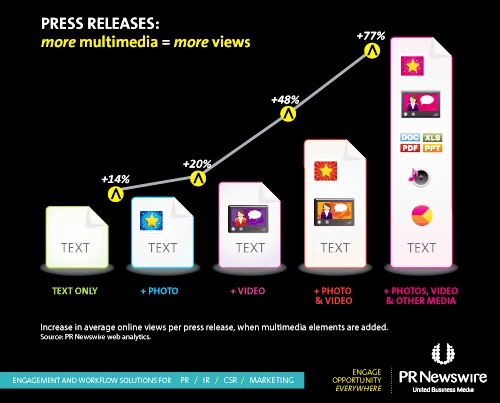When it comes to marketing and branding, there are a few very important things to know about human psychology. For instance, people like shiny things. Well, that’s an oversimplification. More accurately, people are drawn to visually interesting elements that capture the eye. That’s true in the real world, where glitzy billboards and advertisements compete for consumer attention, and on the Web as well.
A page full of text might provide a lot of great information, but you’ll have a hard time engaging readers without including aesthetically pleasing and/or interactive components. Many folks prefer to receive content by hearing or viewing, as opposed to reading, and you’re wise to cater to those tastes if you can.
The graphic below, from PR Newswire, shows just how effective multimedia can be in driving more views. As you can see, a page with three or more multimedia elements can lead to 77 percent more traffic.
No-brainer, right? But there are definitely ways to get it wrong. Read on, and we’ll offer some recommended strategies for implementing multimedia on your site, as well as some cautions against costly mistakes.
Multimedia Strategies
Implement Video on the Page
Outside of basic images, this is the most common and obvious form of multimedia. We’ve written before here about the value of video marketing as a content marketing tool, noting its exceptional engagement and positive SEO impact. According to Digital Sherpa, a website is 50 times more likely to appear on the first page of search results if it includes video.
Use Embedded Audio
Visitors who are browsing your site while multi-tasking enjoy having the capability to click “Play” and listen rather than dedicating their full attention to reading text. In some cases, it might make sense to embed music on a page, but more often it’s a good idea to feature something like a podcast or interview.
 Create a Slideshow
Create a Slideshow
A slideshow is a slick interactive method for presenting galleries of graphics. It allows you to display many images — including captions or descriptive text — in an organized manner, with the user simply clicking arrows to navigate from one to the next. Plus, you can add a narrative aspect because of the sequenced nature of the pictures.
Interactive Chat or Webcast
Why not bring your Web visitors into the conversation? This requires some planning and preparation, but a chat window or a video webcast creates a much more direct form of user engagement. There are many widgets and apps that offer this type of functionality, and using them, you can address questions and comments in a responsive setting.
Design an Infographic
These image-based presentations of stats, data and info are visually rich and very easy to digest. According to Market Domination Media, an infographic is 30 times more likely to be read than a text article. Good infographics also tend to get shared like crazy on social media, dramatically boosting your organic reach.
Multimedia Content Tips
Here are a few guidelines to keep in mind when adding multimedia to your site…
Don’t Overdo It. The downside of most multimedia elements is that they are larger in size and take longer to load. This can bog down web browsers — especially on mobile devices. As some of the statistics above indicate, more photos and videos are usually a good thing, but you need to strike a balance.
Avoid Using Flash. This is very much a personal preference, so take it for what it’s worth. In my experience, Flash animations often cause browsers to malfunction and crash. Flash is not always cross-platform compatible so it may not display properly for visitors on particular devices. Because Flash-based advertisements often cause pages to load slowly, many users choose to disable it. I would steer clear.
Double Up Audio Content With Text. The downside of including valuable content in video or audio form is that web crawlers won’t pick it up, limiting the SEO value. I recommend recapping the key points with accompanying text, making sure to include prioritized keywords.
Don’t Try To Trick Users. Too often, I see websites attempting to use multimedia as a means to fool users into taking a certain action. For instance, you might click an arrow thinking that you’re going to the next image in a slideshow, or a “Play” icon thinking you’re launching a video, only to get taken to an ad. This is horrible for user experience and will not garner the desired results.
How to Add Multimedia to Your Site
Do any of the above techniques sound like something you’d like to try on your page? Our website builders specialize in multimedia-enabled sites that rank on search engines and capture traffic. Get in touch with us today!

